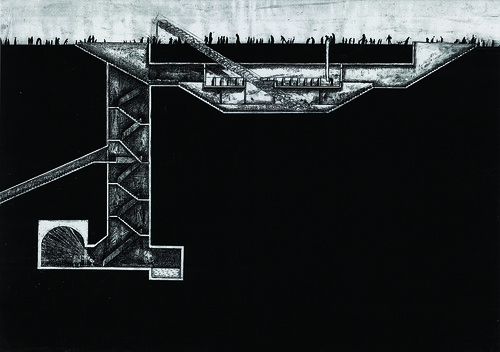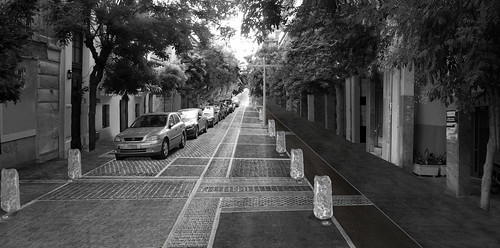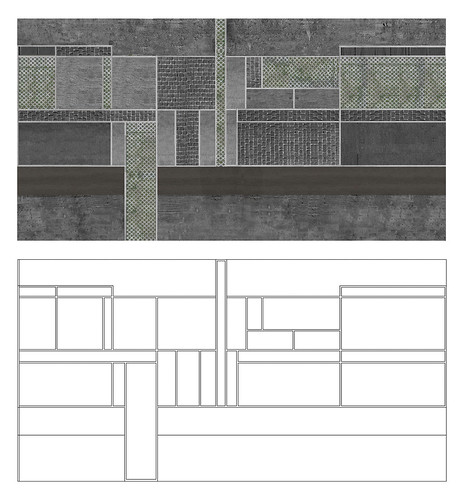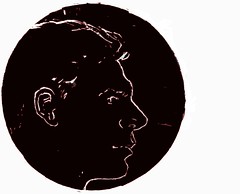Athens and some thoughts on urban mechanisms
The Greek architecture scene is in the same time interesting and problematic following the country’s idiosyncratic financial position in the world. In this condition it seems urgent to think again about the city. The Greek city seems to show a problem of the next decades for the cities of the former west. The city is obviously not only a matter of architecture; on the contrary it seems that architects are distant viewers of phenomena that change radically the city’s consistence. But the most interesting condition for architecture in Greece is the one that is not attentively examined by professionals; the transformations that are taking place now will rule the practice of the city’s constructions in a wider sense during the following years. Athens cannot be thought as the typical western city as conceived some years ago. Athens becomes an exemplary urban congregation that could represent an unknown future city. We have to forget thus for one moment what architects are doing in Greece in order to be more precise describing the Greek architecture: not as a function of what is built by Greek architects but as the complex transformation that takes shape in the Greek capital. The transformation shows in the same time a city ruled by immaterial structures (the city’s digital infrastructures are modernized enough to construct a big part of its communal systems) and -in parallel to this extended immaterial network- a growing problematic materiality appears for the first time after many years in the city streets. The city cannot even feed or host in a satisfactory level its inhabitants. The separation or the schism between problematic material restrictions and "non-problematic" immaterial infinities (both describing normal, pragmatic functions of the present city) is an urban characteristic that may be proved structural for the cities of tomorrow. The population is divided by its relation to the infrastructure. A growing digital network replaces the communal factors of the modern city’s systems. “Participating in the infrastructure” does not only refer to a determination of every infrastructure by digital technologies, (used in order that the water flows in the water network or the electricity is distributed in the extended urban field); many more communal platforms are now already determining the social life of every modern city. The citizens of many contemporary cities are already experiencing the “foundations" of other community structures through digital networks. The platform that was ruling the modern cities as systems of sharing space and as sets of rules for coexistence seem to be less and less important in the construction of urban communities. Other invisible platforms applicable to groups of people communicating via Internet are determining a different social life. In the same time, in Athens, an uncontrolled immigrants wave brought in the empty center of the city different populations. The city was not prepared to accept them. The city's waste and its excrement are the only source of possible life for its new inhabitants. Any concept of waste becomes then crucial for the city’s material function. People are living in abandoned parts of the city. People are systematically searching and collecting different categories of garbage in order to recycle parts of it in order to collect some money. Athens as a city of tomorrow is characterized by its modern derelict empty center. The city's future will have to do with its recent past. Its administrative center was formed as a system of offices and stores that were structuring its street level. A big number of offices are now empty. Many shops are closed. The streets themselves are sometimes inhabited and the buildings that form them are not inhabited any more. The transformation of the city will be decided after a certain control of this city emptiness. We do not know yet what the empty urban centre will be. It is this regulation that will happen with or without the state that will determine the most interesting factor about architecture of tomorrow in Greece, the character and the specificity of a post apocalyptic view concerning the modern remains as an element for the future. Architecture in Greece is determined by the luck of its capital's center. Can this condition give us material to think about an architecture that will perform limited operations with important urban goals? Can some urban strategies be deployed not only in Athens and not only in Greece after this lesson of Athens? The program of the next decades architecture is necessarily fixed: ways to perform constructions in the urban level with minimum cost and maximum of "urban effectiveness". This effectiveness can mean different programs; they can be undertaken in different ways. The character of any possible urban effectiveness and the visions that may lead to action are at stake.
Athens is thus an emblematic city not only because it incarnates a particular relationship to an ancient past; it introduces the western world to the narration of an upcoming global bankruptcy.
Athens re-emerged in the 19th century as the capital of the independent Greek state: The city was then a decadent small town but it was inaugurated as the capital of Greece because of a strong need to incorporate a glorious past of ancient Greece in the new state's rationale. The new city's plan was proposing from its first plan of Kleanthis and Schaubert the incorporation of the ancient remains in the new city axes. The main part of the existing settlement was on the Parthenon. While the archeologists undertook the to highlight the classical remains in the Akropolis, in order to produce one of the most important symbols of origin for the western civilization, the new city of the Bavarian king had to be installed as a proposed reference and a continuation of the ancient city. Concerning the first modern city plans, a triangle defined by important spots as the Parthenon, the ancient cemetery of Kerameikos or the new palace of the Bavarian king introduced the idea of a historic continuation that could immediately relate modern Athens to the glorious time of ancient Greece. Neoclassicism, the international style of this epoch, was the architectural style through which Bavarian, French and Greek architects, educated in Europe, designed the first important public buildings of the new capital. A concern about the loss of values today may be also related to this inaugurative moment of the new Greek capital, where a forgotten past was proposed to be the past of a state that would have to reinvent its language and its history.
This introduction concerning this interesting city can be enriched by a thinking on urbanism; towards some possible reconsideration of values some new notions determine the elements that constitute a community today. The particular moment we begin an investigation for the city and its condition imposes some constitutive elements for the description of the project. A bankruptcy shows a fertile ground for a reinvestigation of the given; in the same time Athens, is a particular city concerning what can be understood as given; this idiosyncratic city's landscape is formed by a contemporary ground covering a population of ruined fragments. A first series of athenian projects were treating aspects of the bifurcated landscape the city provides to any contemplation of it; explanations are given in an older text written in Greek: a particular consideration of the attic landscape serves as a drive for those works. The landscape of Athens is then not considered as a mere visual result but as an intellectual function that introduces, in a surface contemplation, the consideration of an invisible "civilized underground landscape"; an underground field covers the key of the landscape's constitution. The invisible material, organizes the view of the landscape; a missing element rules the gaze to the city. The loss of the ancient town grants visitors a particular place to "visit" and an idiosyncratic way to contemplate. On the modern city level the visitor can observe this complex urban cover, an artificial, self-sustaining built landscape, presented as always already hiding something "more important" than what it reveals; the modern contemplation of the Greek capital is linked to a mooring that recognizes in the observation of the urban phenomena what is lost under the city's ground floor. An idealized, material, existing and in the same time absent underground space is established. Athens is inaugurated as a modern capital through an installation of mooring. Three of the projects treated directly the existence of an idealized earth in Athens.

The first one concerns a rearrangement of Koumoundourou square; the proposal for an excavation of an area that covers important classical and archaic ruins and a recovering move that follows it, offer a city square in this same area. A double periscope was then proposed for a reconsideration of the rupture between the past (understood as a function of an idealized ground depth) and an obvious present. The periscope served as a tool that systematized both a mechanism of idealization and a way to materialize some invisible undeground.
 The second project is called "the one year bridge"; it deals with visible athenian ruins; those ruins are proposed to the visitor as a result of excavation; they lay 4 meters lower than the city streets level. Many areas of Athens are ruled by an undecidability concerning the relation between the lower ancient level and the modern higher one. The "one year bridge" proposes a light construction prolonging Salaminos street to Ermou: a possibility for urban transformations undertaken with light temporary structures is under consideration here. What would a temporary urbanism of this type may lead to? Can we add into a solid urban fabric some important scaffold-like bypasses or street extensions? Insisting on the temporary character of such constructions we may seek the most important changes, experimented with the less solidity. This principle can orient a modern inhabitation of important ruins. How can light, temporary constructions organize important urban acts? Athens is traumatized from inhospitable archaeological voids. It can be locally transformed with the introduction of constructions that may have the structure of the scaffold used by archaeologists. Scaffold-like structures and temporary regulations can transform the city into a field of unfinished projects, research productions in a permanent testing phases. The ruin fields of Athens provide an interesting working hypothesis. The one chosen to be elaborated is the ancient cemetery of Κεραμεικός. A simple prolongation of an existing modern street to one of the more important city axes (Ermou, designed already by Kleanthis and Schaubert in the first modern plan of Athens as a capital of the new Greek state in the 19th century) marks again a continuation in a place where a rupture imposed to the city the void of an archeological site. A traumatic urban act of an excavation intervenes in the street network. The trace of the "one year bridge" overpasses the ruins of Κεραμεικός, proposing a particular view to the ruins of Πομπείον and Δίπυλον that are found there; the wooden bridge provides a new way of contemplating this important but not spectacular ruin ensemble. Maybe this temporal character represented a nightmare for many versions of urbanism of the past; a contemporary urbanism will have to include flexible proposals for some materialization. Cheap, short term materializations would have to replace some of the stable strategies of the past. The question will not any more be to find a correct finished form, but to test alternative possibilities. Another way of understanding an urban field as an archeological territory would be possible if we treated the modern city's equipment as such a system of finds. The Syntagma square project elaborated this idea by proposing transpositions of the piazza's marble stairs in order to install a meditated emptiness.
The second project is called "the one year bridge"; it deals with visible athenian ruins; those ruins are proposed to the visitor as a result of excavation; they lay 4 meters lower than the city streets level. Many areas of Athens are ruled by an undecidability concerning the relation between the lower ancient level and the modern higher one. The "one year bridge" proposes a light construction prolonging Salaminos street to Ermou: a possibility for urban transformations undertaken with light temporary structures is under consideration here. What would a temporary urbanism of this type may lead to? Can we add into a solid urban fabric some important scaffold-like bypasses or street extensions? Insisting on the temporary character of such constructions we may seek the most important changes, experimented with the less solidity. This principle can orient a modern inhabitation of important ruins. How can light, temporary constructions organize important urban acts? Athens is traumatized from inhospitable archaeological voids. It can be locally transformed with the introduction of constructions that may have the structure of the scaffold used by archaeologists. Scaffold-like structures and temporary regulations can transform the city into a field of unfinished projects, research productions in a permanent testing phases. The ruin fields of Athens provide an interesting working hypothesis. The one chosen to be elaborated is the ancient cemetery of Κεραμεικός. A simple prolongation of an existing modern street to one of the more important city axes (Ermou, designed already by Kleanthis and Schaubert in the first modern plan of Athens as a capital of the new Greek state in the 19th century) marks again a continuation in a place where a rupture imposed to the city the void of an archeological site. A traumatic urban act of an excavation intervenes in the street network. The trace of the "one year bridge" overpasses the ruins of Κεραμεικός, proposing a particular view to the ruins of Πομπείον and Δίπυλον that are found there; the wooden bridge provides a new way of contemplating this important but not spectacular ruin ensemble. Maybe this temporal character represented a nightmare for many versions of urbanism of the past; a contemporary urbanism will have to include flexible proposals for some materialization. Cheap, short term materializations would have to replace some of the stable strategies of the past. The question will not any more be to find a correct finished form, but to test alternative possibilities. Another way of understanding an urban field as an archeological territory would be possible if we treated the modern city's equipment as such a system of finds. The Syntagma square project elaborated this idea by proposing transpositions of the piazza's marble stairs in order to install a meditated emptiness.  The Athens toilets project proposes an underground toilet system that brings together the ruins and the modern city's literal excrement. A spectacular interpretation of the sewage system techniques is proposed in a city that has a characteristic relation to its underground space. Treating the shit and the ruin form parallel underground systems that could be handled together.
The Athens toilets project proposes an underground toilet system that brings together the ruins and the modern city's literal excrement. A spectacular interpretation of the sewage system techniques is proposed in a city that has a characteristic relation to its underground space. Treating the shit and the ruin form parallel underground systems that could be handled together.In front of a possible global bankruptcy, Greece may move faster towards an end of financial normality. Athens is in front of a new condition: in the frame of the Greek financial crisis, a dream of return to prior situations may be proved impossible. Athens could be the city of this impossibility; it may also elaborate strategies of transformation, forgetting the past of the city's typical practice and forgetting also some tested old urban strategies, inherited as systematic actions, facing older problems. Some shifting, temporary urban mechanisms can be accepted because of the city's quick transformations. What transformations of the city do we refer to? From the one side a number of the city's immigrants who populated Athens in order to improve their condition are trapped now in Greece without being able to live in a decent way any more. From the other side this same financial condition drives some small businesses to stop their service. This is already obvious in the center of Athens where the presence of emptied shops, free for rent is more and more obvious. In front of this situation we do not seek an impossible final form of a new city but generic micro-schemata that propose systematic answers to typical situations. Systematic architectonic reactions that can run in low budget responses to recorded malfunctions can be proposed with the form of open predetermined platforms: the platforms can frame possible individual contributions by citizens, individuals or the municipality functioning as open calls. The generic schemata could form flexible material strategies related to the general character of an area. Constructions could be proposed as interventions to situations mostly. Maximum changes of situations with minimum expenses would have to form a manual of urban tactics. The questions of drugs, of prostitution, of the important number of immigrants may form an always shifting, continuous urban research; those populations form a moving "unwanted mass" that circulates in the city's core; this is the way those populations are perceived by Athenians and left out of the Athenian urban system. Their urban nomadism creates changes for the real estate; their stability would not make such big profits; the inclusion of those populations into the city’s networks is a legislative target for an athenian urbanism. Those populations remain invisible in a legislative level; we have to invent endings of this invisibility that will provide urban space for any alternative population.
A new Charte of Athens would have to investigate an urbanism of bankruptcy; not a set of rules anymore but as a series of material, possible, local answers, temporary constructions, related to non permanent transformations; the global economy situation, orients towards the unknown. The architecture in front of bankruptcy confronts the challenge of investigating some not normative, neither already tested possibilities : alternative solutions for architectonic problems become obligatory. A systematic research that re-elaborates the values of the early past concerns already architecture and urbanism. Some possible answers constitute narrations that treat the city's particular moment.
 The answers to this condition may lead to idiosyncratic reuses of wasted material of Athens; the project concerning the Athens terraces was proposed in 2008. A system of metallic frames and an elaboration of old metallic grids formed elements that organized horizontal surfaces meant to cover the city's terraces with a metallic pergola; this urban and architectonic structure could serve as a cooling system; selected temporary vegetation would be added in order to organize visitable places. The project can only be accomplished with a transformation of the legislative frame concerning the propriety right and the possible uses of the roofs in this city. A possible realization would enter this strategic view of a new urban rationale for Athens if it provides a frame for works to be undertaken from the inhabitants of each block.
The answers to this condition may lead to idiosyncratic reuses of wasted material of Athens; the project concerning the Athens terraces was proposed in 2008. A system of metallic frames and an elaboration of old metallic grids formed elements that organized horizontal surfaces meant to cover the city's terraces with a metallic pergola; this urban and architectonic structure could serve as a cooling system; selected temporary vegetation would be added in order to organize visitable places. The project can only be accomplished with a transformation of the legislative frame concerning the propriety right and the possible uses of the roofs in this city. A possible realization would enter this strategic view of a new urban rationale for Athens if it provides a frame for works to be undertaken from the inhabitants of each block. 
A similar structure of an empty frame that could welcome reused abandoned material could allow a reconsideration of the athenian street surface. This pattern was elaborated during a workshop concerning a particular area of Athens (Kerameikos - Metaxourgeio). A temporary consortium of Greek architects proposed some works in collaboration with some citizens and interested developers. The one proposed by Antonas office deals with a strategy of the urban surface of the street.

An irregular grid, composed by linear concrete elements, structure the platform of this design. The empty rectangular surfaces are prepared to host construction waste or to reuse unwanted material. The project describes a pattern and, in the same time, it proposes a way of filling the empty surfaces that are formed by this pattern's installation: a visit to the municipality's warehouses of construction materials proves that there are a lot of wasted or second hand materials, not usable because found in small quantities. A construction material can be composed by a recycled waste of the Athens market; glass and aluminum cubes can be treated in order to be usable for those surfaces. The motley material will be used to complete this pattern and finish the surface of the proposed urban floor in an analogous way a traditional Greek tissue, kourelou, was composed by remains of old clothes.





No comments:
Post a Comment